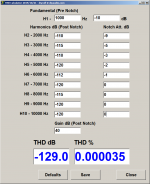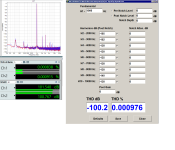The AP uses a state variable filter with feedback for its notch I believe. That makes it easy to get a very small attenuation for H2. And easy to tune via a multiplying DAC.
Otherwise you need a jillion relays to have enough resolution.
The B&K passive notch filter has a correction for harmonics but with 20 dB insertion loss. I have not had the patience to reverse engineer it and the manual has no circuit info, quite unusual for B&K in that period.
I think it would be trivial to sweep and store a loss/phase curve of the filter and apply it to a measured distortion.
Otherwise you need a jillion relays to have enough resolution.
The B&K passive notch filter has a correction for harmonics but with 20 dB insertion loss. I have not had the patience to reverse engineer it and the manual has no circuit info, quite unusual for B&K in that period.
I think it would be trivial to sweep and store a loss/phase curve of the filter and apply it to a measured distortion.
In the old beginning days I had a HAMEG HM8027 THD Analyzer. This HM8027 required the HM8000 ground module for operation as with other nice bargain modules at the old times.
There was 3 freq. ranges to select and one button to tune close to the fundamental until the device locked/snapped to the fundamental. Had a 0.01 % lowest reading & calibration and an output of residual filtered fundamental as the harmonic's... The used TL074 could be replaced with lower noise opamps.
While I do not have them anymore, interesting would be to measure the noise & THD of this residual signal. Whether the circuit is good enough for LDO measurement.
In other words, the HM8027 is obsolete but the service manual with full circuit is still around the internet.
just a from the old days...
There was 3 freq. ranges to select and one button to tune close to the fundamental until the device locked/snapped to the fundamental. Had a 0.01 % lowest reading & calibration and an output of residual filtered fundamental as the harmonic's... The used TL074 could be replaced with lower noise opamps.
While I do not have them anymore, interesting would be to measure the noise & THD of this residual signal. Whether the circuit is good enough for LDO measurement.
In other words, the HM8027 is obsolete but the service manual with full circuit is still around the internet.
just a from the old days...
I have very average results, nothing interesting to show. Second question - I haven't measured that.Xonar Essence has the CS5381. The same as my Xonar D2 has. This chip is one of the best.
What the residual harmonics you can measure with your Essence? What is the input signal level (dBFs) in the best linearity region of your card (when the residual harmonics become invisible)?
I am talking about noise, of cause.Averaging won't change a thing, unless it's synchronized and is performed in either vector FFT or time domain. Then it will reduce noise only, like 20-30dB of noise reduction.
Any averaging that reduces harmonics is faulty
The passive variable notch filter with and without active circuit modification applied. [July 2016 file date]
I used this to tune out a harmonic. Some generators can have 2H nulled but 3H is then higher --- tune gen to reduce one harmonic and other is higher. But with notch, you tune out the remaining Harmonic for exceptionally low residual. I need two notch filters locked with each other would be best. hint hint
Note-- No atten of 2H with active switched in.
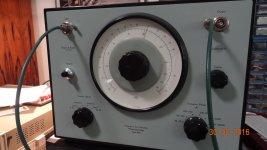
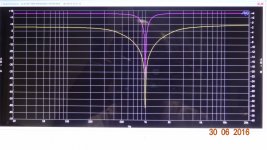
This is so far possible to measure and obtain with -100dbv cal reference signal = 0 -->
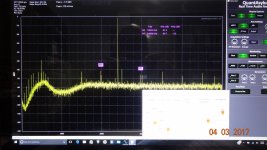
Davada's Gen . Retuned for 1Khz best perf.
THx-RNMarsh
I used this to tune out a harmonic. Some generators can have 2H nulled but 3H is then higher --- tune gen to reduce one harmonic and other is higher. But with notch, you tune out the remaining Harmonic for exceptionally low residual. I need two notch filters locked with each other would be best. hint hint
Note-- No atten of 2H with active switched in.


This is so far possible to measure and obtain with -100dbv cal reference signal = 0 -->

Davada's Gen . Retuned for 1Khz best perf.
THx-RNMarsh
Last edited:
The passive variable notch filter with and without active circuit modification applied. [July 2016 file date]
View attachment 788509
This is so far possible to measure and obtain with -100dbv cal reference signal = 0 -->
THx-RNMarsh
How does your active Notch circuit look's like?
Did you also measured the noise & THD contribution of this active notch?
Hp
How does your active Notch circuit look's like?
Did you also measured the noise & THD contribution of this active notch?
Hp
It was a basic dual opamp config notch filter... each used in X1 config. No I did not measure its contribution.
Seemed to be just the dist and noise of the passive parts.
sorry
maybe something like this without input buffer --->
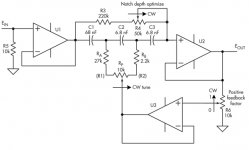
-RM
Last edited:
I made a small tool for THD calculation. Please post any errors here.
You could add "noise level" parameters and then calculate the values with better precision and get better (lower) THD values.
https://www.edn.com/design/test-and...g-small-signals-accurately--A-practical-guide
CS5381 in my ASUS STX II, oscillator Victor1k;
as Victor wrote, -130dB
I would like to ask what is the spectrum analyzer software used?
Thank you!
I would like to ask what is the spectrum analyzer software used?
REW REW - Room EQ Wizard Room Acoustics Software , a very good tool with great support.
Generally, the app seems to work.
Ralf what is the user interface? Does it import numbers from the likes of ARTA?
Or do you manually input some numbers and it calculates the rest?
You could check against the AP harmonic analyzer results which provides essentially the same functionality.
It is a subfunction on the digital analyzer panel.
Jan
Last edited:
Good idea: Import the readings from ARTA.
How do I force ARTA put out frequencies that are even?
DFT Spectrum, -
Numpoints, 4096
SamplingRate(Hz), 48000.000000
DFTresolution(Hz), 5.859375
Frequency(Hz), Magnitude(dB)
5.859, -227.979401
11.719, -227.979401
17.578, -227.979401
23.438, -227.979401
29.297, -227.979401
35.156, -227.979401
41.016, -227.979401
46.875, -227.979401
52.734, -227.979401
58.594, -227.979401
64.453, -227.979401
How do I force ARTA put out frequencies that are even?
DFT Spectrum, -
Numpoints, 4096
SamplingRate(Hz), 48000.000000
DFTresolution(Hz), 5.859375
Frequency(Hz), Magnitude(dB)
5.859, -227.979401
11.719, -227.979401
17.578, -227.979401
23.438, -227.979401
29.297, -227.979401
35.156, -227.979401
41.016, -227.979401
46.875, -227.979401
52.734, -227.979401
58.594, -227.979401
64.453, -227.979401
Last edited:
- Home
- Design & Build
- Equipment & Tools
- Low-distortion Audio-range Oscillator
